Proxima b, extremophiles and record-breaking cables Understand article
Science in School is published by EIROforum, a collaboration between eight of Europe’s largest inter-governmental scientific research organisations (EIROs). This article reviews some of the latest news from the EIROs.
CERN: Global open access initiative

Brice / CERN
After three years of successful operation and growth of its SCOAP3 open access initiative, CERN announced that it will continue the global collaboration for three more years. SCOAP3, the Sponsoring Consortium for Open Access Publishing in Particle Physics, is an innovative partnership of over 3000 libraries, funding agencies and research organisations from 44 countries. It has made tens of thousands of scientific articles freely available to everyone, with neither cost nor barrier for any author worldwide.
In co-operation with leading scientific publishers and learned societies, SCOAP3 has supported the transition to open access of key journals in the field of high-energy physics since 2014. In the first three years of SCOAP3 operation, 20 000 scientists from 100 countries have benefitted from the opportunity to publish more than 13 000 open access articles free of charge.
Find out more about SCOAP3.
Based in Geneva, Switzerland, CERN is the world’s largest particle physics laboratory.
EMBL: Dancing embryo cells
For a cell in an embryo, the secret to becoming part of the baby’s body instead of the placenta is to contract more and to carry on dancing, scientists at the European Molecular Biology Laboratory (EMBL) have found.
After a sperm cell fertilises an egg cell, the fertilised egg divides repeatedly, forming a ball of cells. Shortly before the embryo implants in the uterus, some of those cells move inwards. These are the cells that develop into all the baby’s body parts. The cells left on the surface become the placenta, connecting the embryo to the mother’s uterus.
The EMBL scientists found that, in a mouse embryo, whether a cell moves to the middle or stays on the surface depends on how strongly it can contract. The researchers combined experiments and computer modelling, and determined that cells that contract at least one and a half times more strongly than their neighbours move inwards. The findings could one day be relevant for researchers and clinicians doing pre-implantation diagnostic tests on in vitro fertilised (IVF) embryos.
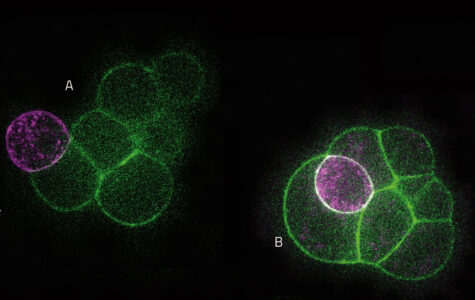
the centre (B) to form the embryo.
Image courtesy of Jean-Léon Maître / EMBL
Learn more about this work on the EMBL website.
See also the original research paper:
Maître JL et al (2016) Asymmetric division of contractile domains couples cell positioning and fate specification. Nature 536: 344–348. doi: 10.1038/nature18958.
Download the article free of charge or subscribe to Nature today.
EMBL is Europe’s leading laboratory for basic research in molecular biology, with its headquarters in Heidelberg, Germany.
ESA: Rosetta’s journey comes to an end
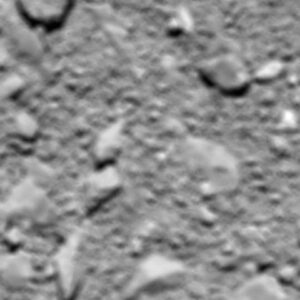
Image courtesy of ESA
ESA’s historic Rosetta mission concluded as planned, with the controlled impact onto the comet it had been investigating for more than two years.
Launched in 2004, Rosetta was in its sixth orbit around the Sun. Its nearly 8 billion kilometre journey included three Earth fly-bys, one Mars fly-by and two asteroid encounters. The craft endured 31 months in deep-space hibernation on the most distant leg of its journey, before ‘waking up’ in January 2014 and finally arriving at the comet in August 2014.
On 30 September 2016, Rosetta carried out its final manoeuvre, setting it on a collision course with the comet from an altitude of about 19 km. During the descent, Rosetta studied the comet’s gas, dust and plasma environment very close to its surface, as well as taking very high-resolution images. Rosetta’s signal was lost upon impact with its target region on the small lobe of Comet 67P / Churyumov-Gerasimenko, and it is now no longer possible to communicate with the spacecraft.
ESA is Europe’s gateway to space, with its headquarters in Paris, France.
ESO: Planet found orbiting nearest star
On 24 August 2016, one of the most exciting discoveries ever in the field of exoplanets was announced at the headquarters of the European Southern Observatory (ESO) in Garching, Germany. Using ESO telescopes and other telescopes around the world, astronomers had found clear evidence of a planet orbiting the closest star to Earth, Proxima Centauri. The long-sought world, designated Proxima b, orbits its cool red parent star every 11 days at a distance of just 7 million kilometres.
Although Proxima b orbits much closer to its star than Mercury does to our Sun, the star itself is far fainter than the Sun. As a result, the estimated temperature of Proxima b would allow the presence of liquid water. This rocky world is a little bigger than Earth and could be the closest possible abode for life outside the Solar System.

star Proxima Centauri.
Image courtesy of ESO / M Kornmesser
Read the full press release here.
ESO is the world’s most productive ground-based astronomical observatory, with its headquarters in Garching, near Munich in Germany, and its telescopes in Chile.
ESRF: Tetrapods transition from water to land
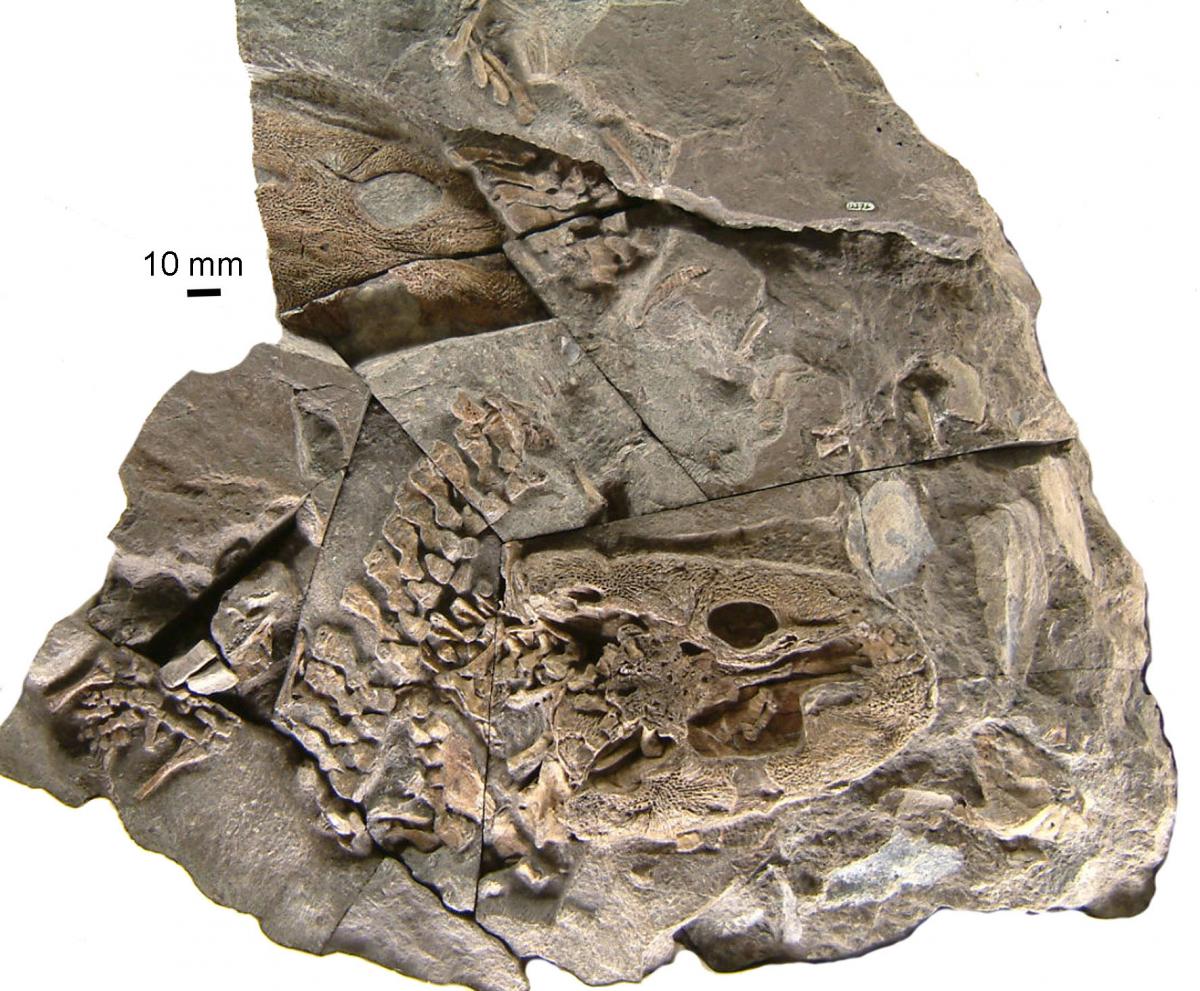
Image courtesy of ESRF / JA
Clack
New research has shed light on the life cycle of aquatic tetrapods, the earliest four-limbed vertebrate animals that ventured onto land. Early tetrapods of the Devonian period (419–359 million years ago) are of great interest to palaeontologists: they paved the way for all future terrestrial vertebrate life, today represented by amphibians, reptiles, birds and mammals.
Well-preserved skeletons of tetrapods are rare, and it was previously assumed that the fossils from the mass-death deposit of Acanthostega tetrapods in Greenland were all adults. Using high-resolution synchrotron X-ray scans of limb bones, however, a team from Uppsala University in Sweden, the European Synchrotron Radiation Facility (ESRF) and the University of Cambridge, UK, has discovered that they are all in fact juveniles, raising questions about how these vertebrates developed.
Read more in the research paper:
Sanchez S et al (2016) Life history of the stem tetrapod Acanthostega revealed by synchrotron microtomography. Nature 537: 408–411. doi: 10.1038/nature19354
Download the article free of charge or subscribe to Nature today.
Situated in Grenoble, France, ESRF operates the most powerful synchrotron radiation source in Europe.
EUROfusion: Record-breaking cables
It’s been an exciting time in the world of superconducting cables. EUROfusion’s Italian consortium member ENEA (Agenzia nazionale per le nuove tecnologie, l’energia e lo sviluppo economico sostenibile) has designed and built a cable that can achieve a record electric current of 81.7 kA; that is 10 000 times greater than what a computer cable can handle. In addition, the electric flow can be achieved under extreme conditions: in a magnetic field of 13 T and a temperature of around -266 °C.
But why does fusion research need such powerful superconducting cables? Tokamak fusion reactors need a large magnetic field to control the very hot plasma of fusion experiments. This requires a high electrical current, which is supplied by superconducting cables. Their unique feature is to transport electricity without losing precious energy to electrical resistance.
The Swiss Plasma Centre, a member of the EUROfusion consortium, carried out the final tests on a rectangular cable-in-conduit conductor. The results showed that the cables exceeded the requirements of the forthcoming world’s biggest fusion experiment: ITER. In fact, the current flow is 20% greater than what is needed for ITER’s magnetic field. The cable has been designed to meet the requirements of DEMO, the demonstration fusion reactor that will hook fusion electricity to the grid.
For more information visit the EUROfusion website.
EUROfusion comprises 28 European member states as well as Switzerland and manages fusion research activities on behalf of Euratom. The aim is to realise fusion electricity by 2050.
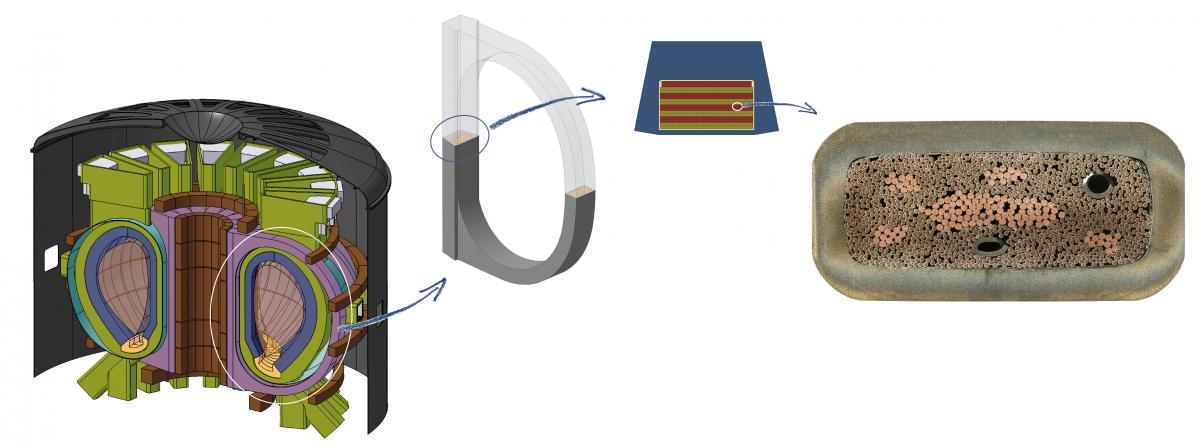
Image courtesy of EUROfusion / Luigi Muzzi
European XFEL: Accelerator ready for action
The 1.7 km long superconducting linear accelerator, a crucial component of the European X-ray Free Electron Laser (European XFEL), is ready for action. The accelerator will energise electrons to extremely high energies, which are needed to generate the European XFEL’s brilliant X-ray laser flashes.
In October 2016, the European XFEL Accelerator Consortium, led by the X-ray laser facility’s largest shareholder DESY, completed manufacturing, testing and installing all of the accelerator’s components. This includes 96 large modules, each 12 m long, in which the electrons are accelerated at a temperature of -271 °C, close to absolute zero.
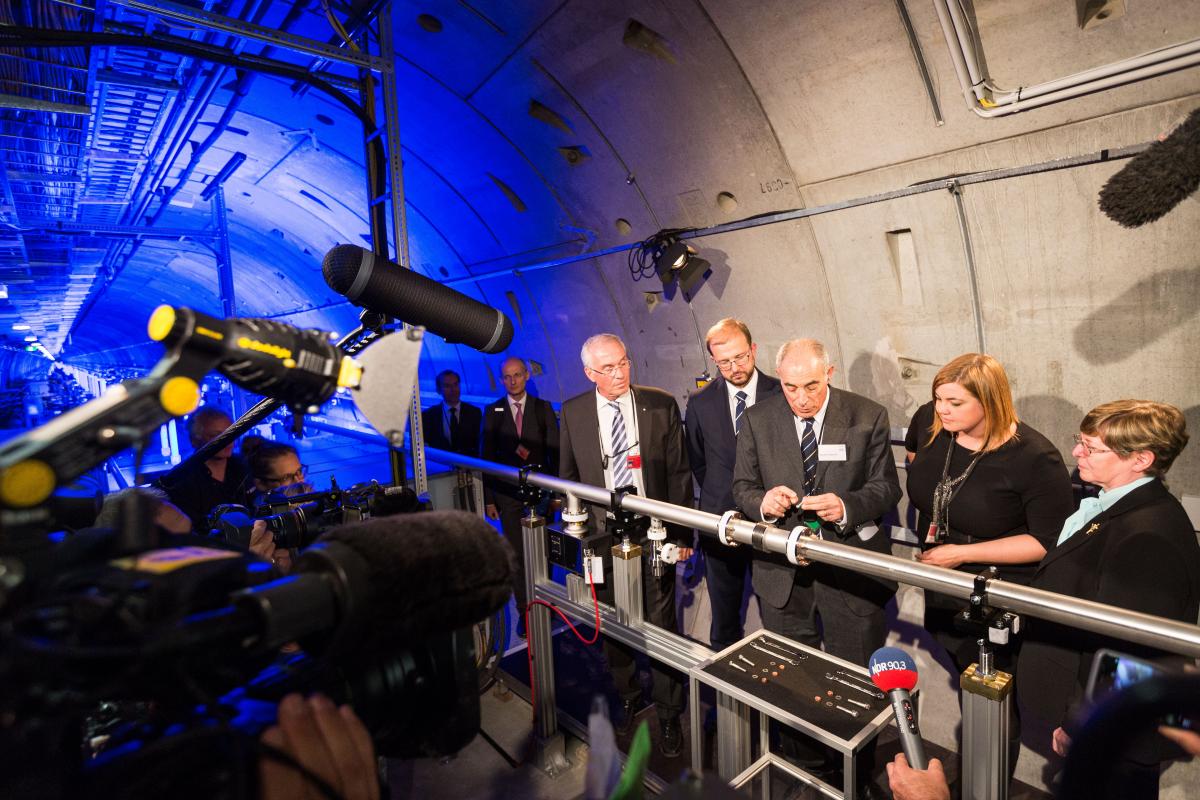
Dr Piotr Dardziński, and Hamburg Science Senator Katharina Fegebank set up
the last beamline at the ceremony officially beginning the facility’s commissioning.
Image courtesy of European XFEL
Commissioning of the accelerator has now started. The electron injector, where the electrons are isolated and given their initial boost, had already been successfully tested in the months before and is performing better than expected.
Now that the accelerator and most of the other components are installed in the underground tunnels, scientists are busily preparing the facility for operation. In October, high-ranking guests from the 11 European XFEL partner countries attended a ceremony marking the start of European XFEL’s commissioning. In mid-2017, European XFEL will open its doors to the first users, supplying them with the unique X-ray laser light that will create new opportunities to study matter.
European XFEL is a research facility currently under construction in the Hamburg area in Germany. Its extremely intense X-ray flashes will be used by researchers from all over the world.
ILL: Neutrons unlock the secrets of extremophile bacteria
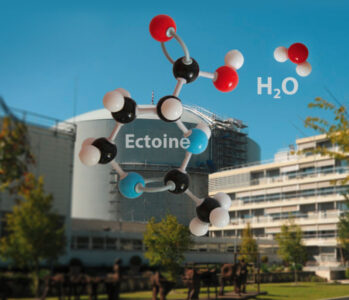
Microbial life has an amazing flexibility for adapting to extreme environments, and understanding their adaptations has important implications for biotechnology.
One species of high biotechnological potential is the recently discovered Halomonas titanicae, a rust-producing extremophile bacterium found in the hull of the sunken ship RMS Titanic. A range of specialised neutron-scattering experiments conducted at the Institut Laue-Langevin (ILL) has estimated that H. titanicae could bring about the total deterioration of the Titanic by 2030; it also poses a problem to oil rigs and other human-made objects in the deep seas. But the rusting property could also be harnessed in bioremediation or waste management, for example to accelerate the decomposition of shipwrecks littering the ocean floor.
H. titanicae isolated from the oceans or salt marshes can reversibly accumulate high concentrations of the osmolyte ectoine within its cells, to counterbalance fluctuating external salt concentrations. The experiments were designed to understand how ectoine permits H. titanicae to survive in its extreme environment. They revealed that within the microbial cells, ectoine enhances the dynamic nature of the hydrogen bonds in the intracellular water, enabling cell functions to proceed unhindered by the external environment.
To find out more, read the press release.
See also the original research paper:
Zaccai G et al (2016) Neutrons describe ectoine effects on water H-bonding and hydration around a soluble protein and a cell membrane. Scientific Reports 6: 31434. doi: 10.1038/srep31434
ILL is an international research centre at the leading edge of neutron science and technology.
EIROforum
EIROforum combines the resources, facilities and expertise of its member organisations to support European science in reaching its full potential.
Read other EIROforum-related articles in Science in School, and browse the other EIRO news articles.






